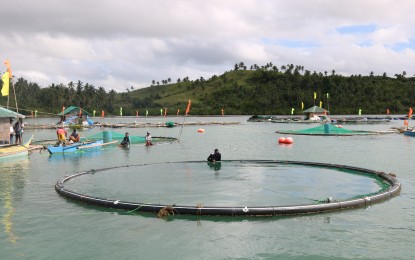
Some of submersible fish cages set up in Basey, Samar. (Photo courtesy of Bureau of Fisheries and Aquatic Resources)
TACLOBAN CITY – At least 45 submersible fish cages developed by Japan have been set up in some parts of Eastern Visayas to minimize fishery losses during destructive natural calamities.
These cages were established last month in Guiuan, Eastern Samar; Basey, Samar; and Tacloban City where marine agriculture zones have been established in the past.
“This project is typhoon-resilient and made of materials that can last more than 20 years. We can lower it during typhoon and save the marine farm from losses,” said Bureau of Fisheries and Aquatic Resources (BFAR) Eastern Visayas Regional Director Juan Albaladejo in a press briefing here Monday.
Citing experiences when Super Typhoon Yolanda struck in 2013, the region’s marine agriculture zone suffered PHP617.8 million losses in fish stocks and damaged PHP321.95 million worth of fish cages.
The project is a product of partnership between BFAR and the Japan International Cooperation Agency (JICA), tapping a technology developed by Nitto Seimo, Japan’s leading maker of knotless nets.
“After Super Typhoon Yolanda, many donors came here to help fishermen, but most of them provided fishing boats that resulted in overfishing. We have to develop more sustainable fishing activities using typhoon-resilient fish cages,” said Hirosawa Jin, representative of JICA Philippines agriculture and agri-business development section.
Albaladejo said the resiliency of these cages had been proven when intense typhoons such as Ruby and Nina struck the region in 2014 and 2016, respectively.
“No damage was recorded on submersible cages while other cages of a different kind in the vicinity suffered damages,” he noted.
The fish cages will be managed by private firms. Fisherfolk will be hired as workers to maintain those and they will get a salary commensurate to their income from operating their own cages. (PNA)
